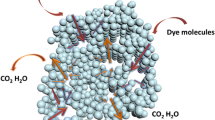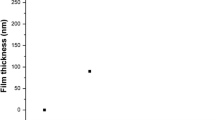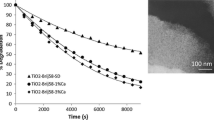Abstract
Variably thick mesoporous TiO2 films were prepared by alternately dip- and spray-coating using sol containing titanium(iv) alkoxide, concentrated HCl and suitable block-copolymer as a structure directing agent. The film thickness was controlled by varying the number of deposited layers. Their porosity was homogeneous: surface area and pore volume increased linearly with increasing number of deposited layers. Photoactivity of the films was tested employing photocatalytic degradation of 10-4 M 4-chlorophenol in a 60 mL photoreactor under UV irradiation at 365 nm. The incident light intensity was 1 mW cnr2. The degradation rate constants increased with increasing number of layers, proportional to their absorbances. However, the progressive improvement of the photocatalytic performance slightly decreased with the increasing number of layers. The spray-coating layers exhibited lower photocatalytic performance due to their smaller thicknesses.
Similar content being viewed by others
Notes and references
F. Bosc, D. Edwards, N. Keller, V. Keller and A. Ayral, Mesoporous TiO2-based photocatalysts for UV and visible light gas-phase toluene degradation, Thin Solid Films, 2006, 495, 272–279.
M. Wark, J. Tschirch, O. Bartels, D. Bahnemann and J. Rathousky, Photocatalytic activity of hydrophobized mesoporous thin films of TiO2, Microporous Mesoporous Mater., 2005, 84, 247–253.
J. Rathousky, D. Fattakhova-Rohlfing, M. Wark, T. Brezesinski and S. Smarsly, Illumination-induced properties of highly ordered mesoporous TiO2 layers with controlled crystallinity, Thin Solid Films, 2007, 515, 6541–6543.
J. Tschirch, D. Bahnemann, M. Wark and J. Rathousky, A comparative study into the photocatalytic properties of thin mesoporous layers of TiO2 with controlled mesoporosity, J. Photochem. Photobiol, A, 2008, 194, 181–188.
P. Yang, D. Zhao, D. I. Margolese, B. F. Chmelka and G. D. Stucky, Generalized syntheses of large-pore mesoporous metal oxides with semicrystalline frameworks, Nature, 1998, 396, 152–155.
C. J. Brinker, Y. F. Lu, A. Sellinger and H. Y. Fan, Evaporation-induced self-assembly: nanostructures made easy, Adv. Mater, 1999, 11, 579–585.
C. Sanchez, C. Boissiere, D. Grosso, C. Laberty and L. Nicole, Design, synthesis, and properties of inorganic and hybrid thin films having periodically organized nanoporosity, Chem. Mater, 2008, 20, 682–737.
J. Rathousky, V. Kalousek, Ch. Walsh and A. Bourgeois, Texture and adsorption properties of multilayer ordered mesoporous films, IZC -IMMS 2010 - Sorrento (Italy), 2010, 1447–1448.
J. Rathousky, V. Kalousek, V. Yarovyi, M. Wark and J. Jirkovsky, A. low cost procedure for the preparation of mesoporous layers of TiO2 efficient in the environmental clean-up, J. Photochem. Photobiol, A, 2010, DOI: 10.1016/j.jphotochem.2010.06.002.
U. Stafford, K. A. Gray and P. V. Kamat, Radiolytic and TiO2-assisted photocatalytic degradation of 4-chlorophenol - a comperative-study, J. Phys. Chem., 1994, 98, 6343–6351.
X. Li, J. W. Cubbage, T. A. Tetzlaff and W. S. Jenks, Photocatalytic degradation of 4-chlorophenol. 1. The hydroquinone pathway, J. Org. Chem., 1999, 64, 8509–8524.
X. Li, J. W. Cubbage and W. S. Jenks, Photocatalytic degradation of 4-chlorophenol. 2. The 4-chlorocatechol pathway, J. Org. Chem., 1999, 64, 8525–8536.
I. M. Butterfield, P. A. Christensen, A. Hamnett, K. E. Shaw, G. M. Walker and S. A. Walker, Applied studies on immobilized titanium dioxide films as catalysts for the photoelectrochemical detoxification of water, J. Appl. Electrochem., 1997, 27, 385–395.
K. Vinodgopal, S. Hotchandani and P. V. Kamat, Electrochemically assisted photocatalysis - TiO2 particulate film electrodes for photocatalytic degradation of 4-chlorophenol, J. Phys. Chem., 1993, 97, 9040–9044.
K. Vinodgopal, U. Stafford, K. A. Gray and P. V. Kamat, Electrochemically assisted photocatalysis. 2. The role of oxygen and reaction intermediates in the degradation of 4-chlorophenol on immobilized TiO2 particulate films, J. Phys. Chem., 1994, 98, 6797–6803.
A. Mills and J. Wang, Photomineralisation of 4-chlorophenol sensitised by TiO2 thin films, J. Photochem. Photobiol, A, 1998, 118, 53–63.
D. Hufschmidt, D. Bahnemann, J. Testa, Juan, C. A. Emilio and M. A. Litter, Enhancement of the photocatalytic activity of various TiO2 materials by platinisation, J. Photochem. Photobiol, A, 2002, 148, 223–231.
S. Bakardjieva, J. Subrt, V. Stengl, E. Vecernikova and P. Bezdicka, Comparison of photocatalytical properties of anatase and rutile TiO2 in degradation of 4-chlorophenol in aqueous solution, diffusion and defect data-solid state data, Solid State Phenom., 2003, 90–91, 7–12.
K.-W. Kim, E.-H. Lee, Y-J. Kim, M.-H. Lee, K-H. Kim and D.-W. Shin. A relation between the non-stoichiometry and hydroxyl radical generated at photocatalytic LiO2 on 4CP. decomposition J. Photochem. Photobiol, A, 2003, 159, 301–310.
X.-M. Pan, M. N. Schuchmann and C. von Sonntag, Oxidation of benzene by the OH radical. A product and pulse radiolysis study, J. Chem. Soc., Perkin Trans. 2, 1993, 289–297.
K. Macounova H. Krysova, J. Ludvik and J. Jirkovsky, Kinetics of photocatalytic degradation of diuron in aqueous colloidal solutions of Q-LiO2 particles, J. Photochem. Photobiol, A, 2003, 156, 273–282.
Author information
Authors and Affiliations
Corresponding author
Additional information
This paper is published as part of the themed issue of contributions from the 6th European Meeting on Solar Chemistry and Photocatalysis: Environmental Applications held in Prague, Czech Republic, June 2010.
Rights and permissions
About this article
Cite this article
Rathouský, J., Kalousek, V., Kolář, M. et al. Mesoporous films of TiO2 as efficient photocatalysts for the purification of water. Photochem Photobiol Sci 10, 419–424 (2011). https://doi.org/10.1039/c0pp00185f
Received:
Accepted:
Published:
Issue Date:
DOI: https://doi.org/10.1039/c0pp00185f




